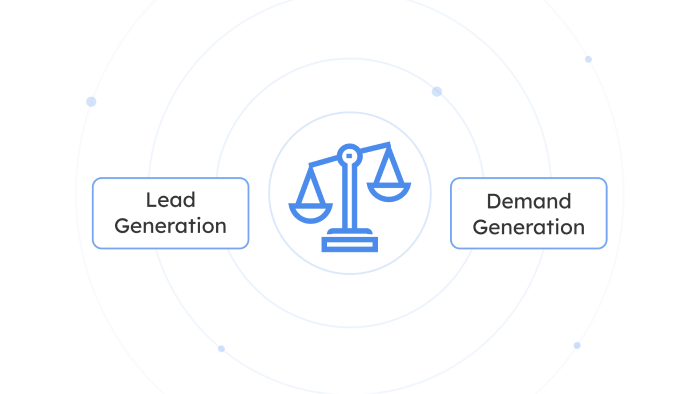Demand generation and lead generation are not the same. As someone that used to do CrossFit and has some strong opinions, this being one of them, I almost cringe when people use those terms interchangeably.
So I’m mainly writing this to have something of my own to share when someone eventually mixes them up again. In this article, I’ll break down what I’ve learned about the differences between both and examples of when and where to use them.
Demand Generation
Demand generation is all marketing and sales tactics you use to drive brand awareness. This is how you build an audience around your solutions and present your products and services. Demand gen happens before hand-raising and before anyone is necessarily interested in your solutions. I think ABM done right is a great demand gen tactic.
Here's what demand generation looks like for B2B SaaS:
- Educating prospects about their pain points.
- Eliminating any friction a prospect might have if they decide to switch to your solutions so that when they’re ready to switch, it’s an easy choice.
- Delivering value for free to help you stay top of mind. This is why you’ll hear a lot of demand gen marketers talking about ungated content that provides value to prospects without asking for anything in return. That way you build trust and the next time they think of a solution to their problems, they’ll think of you first.
- Focusing on attracting people to the top of the funnel that you can then convert.
- Driving the right type of traffic to you. You don’t need to tell people much more about your solutions because they already come in educated.
- Demand Gen typically results in more evangelists. People that rave about your solutions to others, sometimes even without being your customer.
Here are the main steps you need to consider when planning a demand generation campaign:
- Facilitate self-reported attribution: make sure to include an open-ended question like "how did you hear about us?" in your forms. This will help you determine the right channels and content to use to reach out to your audience.
- Create relevant content: once you've established and tested out your ICP and personas, make sure to create relevant content that drives awareness and educates your prospects about their pain points.
- Explore the right channels: self-reported attribution should help you figure out your ICP's watering holes and some of those conversations they have that you can attribute in your CRM. Connect with your audience through those channels and make sure you're only providing value. For free.
- Cultivate relationships with the right cadences: once you find those platforms, make sure to test out the right cadences to publish your content and reach out to your audience. You're mainly reaching out to build better relationships, understand their pains, and potentially start to educate them about your solutions.
Lead Generation
Lead Generation on the other hand is collecting information about your prospects and moving them down the funnel. This is basically everything you do once someone raises their hand and says I’m interested.
Here's what lead generation looks like for B2B SaaS:
- Capturing leads that are already problem-aware and are shopping for solutions.
- Conducting competitive research to make sure that your value propositions resonate more with your prospects than with your competitors, especially since your prospects are typically then in the consideration stage of your funnel.
- Getting as much information from a lead as possible to help push them down the funnel.
- Targeting converting leads in the short run to drive revenue.
Below is a quick snapshot of some of the main differences between demand generation and lead generation for your B2B SaaS business:
| |
Demand Generation |
Lead Generation |
| Type of content: |
Ungated content that delivers high value |
Gated content with lead forms |
| Example: |
Podcasts, webinars, blogs |
Outbound emails with "book a demo" CTAs |
| CTAs: |
"Learn More" |
"Download Now" |
| Goaled on: |
Funnel impact and pipeline acceleration |
MQLs, number of webinar registrants, downloads |
| Funnel stage: |
Awareness and some consideration |
Consideration and decision |
| Answers the question: |
"Why should I change?" |
"Why now?" |
| Addresses: |
Prospects' pain points |
Prospects' gains from working with you |
| Focuses on: |
Building trust and credibility |
Collecting info for sales |
| Sales cycles: |
Short, typically because you've already done a lot of educating and they come in knowing you |
Long, typically because you spend a lot of time educating prospects on your solutions |
| Conversion rates: |
High, those are people that are coming straight to you |
Low, those are mostly prospects that are shopping around and kicking tires |
| Average deal sizes: |
High |
Low |
I think that in order to have a successful, scalable, SaaS marketing function, you need both demand generation and lead generation. One focuses on the low-hanging fruit, so to speak, while the other (demand generation) is planting the tree. You need to pick the fruit to eat and keep your company running, but you also need to plant seeds that will eventually grow into trees that feed you in the future.
Word to the wise: don't let an obsession with attribution prevent you from running demand generation campaigns!
